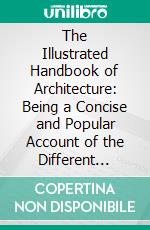History of Indian and Eastern Architecture (Illustrated Edition). E-book. Formato Mobipocket - 9788835362777
di James Fergusson
edito da IONLINESHOPPING.COM , 2020
Formato: Mobipocket - Protezione: nessuna
During the nine years that have elapsed since I last wrote on this subject, very considerable progress has been made in the elucidation of many of the problems that still perplex the student of the History of Indian Architecture. The publication of the five volumes of General Cunningham’s ‘Archæological Reports’ has thrown new light on many obscure points, but generally from an archæological rather than from an architectural point of view; and Mr. Burgess’s researches among the western caves and the structural temples of the Bombay presidency have added greatly not only to our stores of information, but to the precision of our knowledge regarding them.
For the purpose of such a work as this, however, photography has probably done more than anything that has been written. There are now very few buildings in India—of any importance at least—which have not been photographed with more or less completeness; and for purposes of comparison such collections of photographs as are now available are simply invaluable. For detecting similarities, or distinguishing differences between specimens situated at distances from one another, photographs are almost equal to actual personal inspection, and, when sufficiently numerous, afford a picture of Indian art of the utmost importance to anyone attempting to describe it.
These new aids, added to our previous stock of knowledge, are probably sufficient to justify us in treating the architecture of India Proper in the quasi-exhaustive manner in which it is attempted, in the first 600 pages of this work. Its description might, of course, be easily extended even beyond these limits, but without plans and more accurate architectural details than we at present possess, any such additions would practically contribute very little that was valuable to the information the work already contains.
The case is different when we turn to Further India. Instead of only 150 pages and 50 illustrations, both these figures ought at least to be doubled to bring that branch of the subject up to the same stage of completeness as that describing the architecture of India Proper. For this, however, the materials do not at present exist. Of Japan we know almost nothing except from photographs, without plans, dimensions, or dates; and, except as regards Pekin and the Treaty Ports, we know almost as little of China. We know a great deal about one or two buildings in Cambodia and Java, but our information regarding all the rest is so fragmentary and incomplete, that it is hardly available for the purposes of a general history, and the same may be said of Burmah and Siam. Ten years hence this deficiency may be supplied, and it may then be possible to bring the whole into harmony. At present a slight sketch indicating the relative position of each, and their relation to the styles of India Proper, is all that can well be accomplished.
Contents
Buddhist architecture -- Jaina architecture -- Architecture in the Himalayas -- Dravidian style -- Chalukyan style -- Northern or Indo-Aryan style -- Indian Saracenic architecture -- Further India -- China.
For the purpose of such a work as this, however, photography has probably done more than anything that has been written. There are now very few buildings in India—of any importance at least—which have not been photographed with more or less completeness; and for purposes of comparison such collections of photographs as are now available are simply invaluable. For detecting similarities, or distinguishing differences between specimens situated at distances from one another, photographs are almost equal to actual personal inspection, and, when sufficiently numerous, afford a picture of Indian art of the utmost importance to anyone attempting to describe it.
These new aids, added to our previous stock of knowledge, are probably sufficient to justify us in treating the architecture of India Proper in the quasi-exhaustive manner in which it is attempted, in the first 600 pages of this work. Its description might, of course, be easily extended even beyond these limits, but without plans and more accurate architectural details than we at present possess, any such additions would practically contribute very little that was valuable to the information the work already contains.
The case is different when we turn to Further India. Instead of only 150 pages and 50 illustrations, both these figures ought at least to be doubled to bring that branch of the subject up to the same stage of completeness as that describing the architecture of India Proper. For this, however, the materials do not at present exist. Of Japan we know almost nothing except from photographs, without plans, dimensions, or dates; and, except as regards Pekin and the Treaty Ports, we know almost as little of China. We know a great deal about one or two buildings in Cambodia and Java, but our information regarding all the rest is so fragmentary and incomplete, that it is hardly available for the purposes of a general history, and the same may be said of Burmah and Siam. Ten years hence this deficiency may be supplied, and it may then be possible to bring the whole into harmony. At present a slight sketch indicating the relative position of each, and their relation to the styles of India Proper, is all that can well be accomplished.
Contents
Buddhist architecture -- Jaina architecture -- Architecture in the Himalayas -- Dravidian style -- Chalukyan style -- Northern or Indo-Aryan style -- Indian Saracenic architecture -- Further India -- China.
Ean
9788835362777
Titolo
History of Indian and Eastern Architecture (Illustrated Edition). E-book. Formato Mobipocket
Autore
Editore
Data Pubblicazione
2020
Formato
Mobipocket
Protezione
nessuna
Punti Accumulabili







